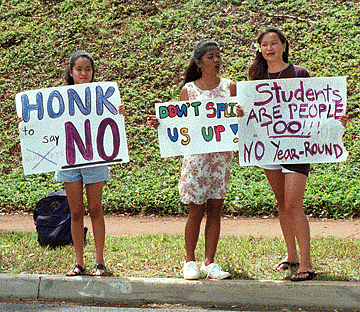
Mililani students protested with "no year-round" and other signs,
above and below, in May. Photo by Ken Ige, Star-Bulletin

Mililani students protested with "no year-round" and other signs,
above and below, in May. Photo by Ken Ige, Star-Bulletin
 The newly air-conditioned buildings may be all some students like about going to a year-round school schedule, but Principal Steve Quon said the school community as a whole is adjusting well to the change.
The newly air-conditioned buildings may be all some students like about going to a year-round school schedule, but Principal Steve Quon said the school community as a whole is adjusting well to the change.
They hardly had a choice.
"We're on almost 17 acres, the second-smallest high school in the district, and we have over 4,000 students," Quon said. "I just in all good conscience couldn't put all those kids on this campus and consider it a safe and healthy environment."
So Marshall High, like 16 other Los Angeles high schools, has divided its student body into three groups and given each a separate starting date, spreading the academic year over a full calendar year. At any given time, including summer, two-thirds of the student body is in school.
A staggered, or multitrack, schedule is becoming an increasingly popular way for financially strapped school districts to cope with overcrowding, and many Hawaii officials are eager to join the experiment. But the state appears to be further away from doing so than originally thought.
Mililani High School was to be the first public school in Hawaii to adopt a year-round, multitrack schedule, winning the blessing of its School/Community-Based Management Council in March. Some public elementary schools are already on year-round schedules, but with all students on the same schedule.
The school's teaching staff of about 130 must approve the change, but so far no consensus has been reached, Ginlack said. It is too late to put the new schedule in place for the 1997-98 school year, he said.
Ginlack said he is disappointed by the delay.
"At times it's frustrating because you see the need for something and you want to move ahead on it," he said. "But also you can understand it because you really want people to buy into and believe what you're trying to accomplish. It's not a good feeling to do something and have a lot of people think this is not what we ought to be doing."
With 2,375 students, Mililani is the state's largest public school. It is designed for 2,000 students but is expected to grow to nearly 3,000 by the end of the century.
"Mililani's not going to get another high school. That's a fact," Ginlack said. It would cost $70 million to build a new school, but roughly $400,000 to implement the schedule change, he said.
Under a year-round schedule, students would still attend school for 180 days of the year but would take shorter and more frequent breaks.
ules, taking no more than 10 weeks off during the summer. Those schedules were adapted to try to improve students' academic performance, with the idea that students would retain more without a long summer break.
Molokai's four elementary schools will be the first to start the new academic year July 24 after a seven-week break.
At Waialae Elementary, among the nine schools going year-round for the first time this year, fifth-grade teacher Shirland Yoshimura welcomes the change.
"I'm not sure how it will actually turn out, but it's a nice concept," she said. "I think children kind of get rejuvenated taking the breaks, and I think they get a lot more excited when you have those breaks in between."
Mililani junior Sasha Tamura, 16, said she wouldn't mind going to school year-round, but she doesn't support a multitrack schedule. With a younger sibling attending Wheeler Elementary, she said her parents worry it will be impossible for the family to coordinate vacation schedules.
"They think it's (multitrack is) junk," Tamura said. "If you're going on vacation and two kids are in two tracks and both parents work, it won't work.
"Actually, Mililani's not that crowded," she added. "At lunchtime it is, but the classrooms aren't that crowded."
Chuck Higgins, coordinator for year-round schools for the state Department of Education, said families with two or more children in the school system will be given preference in selecting tracks.

Waialae Elementary School is one of many schools which have adopted
a year-round schedule. Fifth-grade teacher Shirland Yoshimura thinks
the children will be
rejuvenated by the extra breaks.
Photo by George F. Lee, Star-Bulletin
The state Board of Education is considering a policy that would ask overcrowded schools to consider ways to make the school environment more personal, such as adopting a multitrack schedule or creating "schools within a school."
Ninety-four of the state's 238 schools have more students than they are designed for.
Aside from vacation difficulties, Higgins said varying school schedules will create payroll hassles, but he said the academic benefits make the change more than worthwhile for schools like
Mililani.
Quon said the schedule hasn't hurt his school academically - Marshall High won the national Academic Decathlon in Chicago last year.
But he said the "jury's still out" on whether overall academic performance has improved after two years on a year-round schedule.
The most obvious benefit is that students have more breathing room, and that has helped ease gang tensions, he said.
"I don't consider year-round the cure-all, but for us, in all fairness, it had to be the only way out at the time," Quon said.